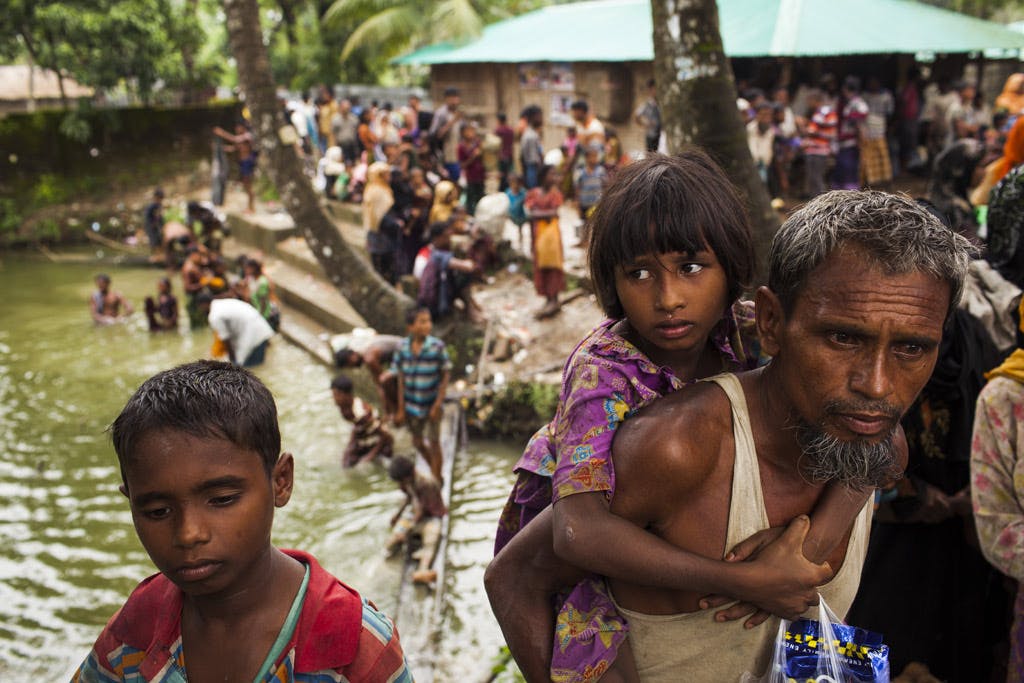After fleeing oppression and violence in Myanmar, nearly 1 million Rohingya refugees in Bangladesh’s Cox Bazar district now face another life-threatening challenge: monsoon season. United Nations’ agencies are responding to help refugees, but they need more resources and support to deliver what is required. Here is what you need to know about the threat and how your support can help to the UN protect Rohingya refugees.
Donate to the UN Humanitarian Fund for Rohingya Refugees
Rohingya refugees face the threat of monsoons in already-fragile refugee camps. Here’s how you can help ❤ ➡ https://t.co/AAxX1Qh4Xl pic.twitter.com/wzpF05NzRu
— UN Humanitarian (@UNOCHA) May 30, 2018
A New Threat
To put the crisis in perspective, the scale of the recent influx of refugees since August 2017 has been nearly equivalent to the entire population of Washington, D.C. settling in an area less than 8% the size of the land where they came from. And the mega-camps of Cox’s Bazar, which are surrounded by vulnerable, eroded land cleared for shelter happen to be located in one of the most frequently flooded regions in the world.
Most of Bangladesh’s rainfall – 80% – occurs during monsoon season, which officially began in June and lasts until October. This year, incoming downpours present countless dangers to the men, women, and children settled among crowded, makeshift shelters across sharply sloped hills. Heavy rainfall and cyclones not also raise serious concerns for injuries and death from flash-floods and landslides but for water sanitation, disease outbreak, the provision of health services, and more.
As the first rains of monsoon season descend, the UN is swiftly mobilizing to combat an array of risks through a coordinated, multi-agency response with the government of Bangladesh and aid organizations.
Here are six key ways the UN is taking action to protect Rohingya refugees this monsoon season – and why your help matters:
- Relocating to Safer Ground
According to studies from the UN Migration Agency (IOM), an estimated 120,000 people in Cox’s Bazar will be at grave risk from flooding and landslides over the next several months. To reduce these risks, IOM, the UN Refugee Agency (UNHCR), and the World Food Programme (WFP) established the Joint Maintenance Engineering Project to create structural solutions. One key output is the preparation of a 12-acre plot on stable ground for shelters and other key services for nearly 500 families currently living on sandy hillsides on some of the most at-risk parts of the site.
- Strengthening Shelters
For those who cannot be immediately relocated, UN agencies are working to distribute shelter upgrade kits, containing ropes, bamboo, tarpaulin, and tools, to more than 120,000 households. IOM is also helping to strengthen and stabilize shelters by leading community training on shelter upgrades and disaster risk reduction. So far, more than 37,000 households have been trained.
- Dredging and Renovating Canals
As part of the Joint Maintenance Engineering Project, UN agencies are dredging and renovating over nine kilometers of abandoned canals in Cox’s Bazar’s Ukhiya sub-district to prevent flooding and allow water runoff during heavy rains. In addition, renovation efforts will also clear key access roads to ensure the continued flow of aid and services.
- Promoting the Health of Girls and Women
Since the Rohingya refugee crisis began, the UN Population Fund (UNFPA) has established reproductive health clinics and safe spaces in the camps of Cox’s Bazar to address the health needs of women and girls, including providing essential antenatal care to more than 72,000 women. Since these needs do not go away in natural disasters, UNFPA is reinforcing existing structures to withstand heavy rains and preparing contingency plans, such as relocating services.
- Minimizing Hunger
In addition to ensuring the safe delivery of food by improving drainage channels and stabilizing slopes, WFP is expanding its e-voucher program to cover all existing refugees and the influx of new refugees. Currently, more than 800,000 refugees in Cox’s Bazar receive WFP food assistance every month. To minimize increasing vulnerability to hunger, the e-voucher program will give families more flexibility to when they can shop and what foods they can eat, including greater access to more nutritious foods such as vegetables, eggs, and dried fish.
- Addressing Health Risks
Floods pose numerous risks to health and well-being – from immediate injuries to the transmission of water-borne diseases, including dysentery and cholera, in the aftermath. The World Health Organization (WHO) and UN partners are enacting disaster-response plans to ensure health services: relocating health facilities vulnerable to flooding, establishing rehydration points, continuing vital vaccine campaigns, and more.
How You Can Help
Of course, these key six actions do not capture everything that the UN and its partners are doing – much more is happening and much more needs to be done. All of these vital efforts require robust funding and support; however, current UN appeals for lifesaving assistance remain only 21% funded. Here are two simple ways you can help UN carry out life-saving and life-sustaining actions:
- Donate
Donate to UN relief efforts or hold a fundraiser on social media to encourage your family and friends to support refugees who urgently need help.
- Raise Your Voice
Share what’s happening about the Rohingya refugee crises with your friends, families, and social networks.
Photo: UNHCR, Roger Arnold

